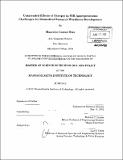Unintended effects of changes in NIH appropriations : challenges for biomedical research workforce development
Author(s)
Diaz, Mauricio Gomez
DownloadFull printable version (8.239Mb)
Alternative title
Unintended effects of changes in National Iinstitutes of Health appropriations
Challenges for biomedical research workforce development
Other Contributors
Massachusetts Institute of Technology. Technology and Policy Program.
Advisor
Richard C. Larson.
Terms of use
Metadata
Show full item recordAbstract
The U.S. government doubled NIH appropriations between 1998 and 2003, aiming to significantly foster research activities in biomedicine. However, several indicators demonstrate not only that the impact of the budget increase fell short of expectations; in many cases it resulted in unintended negative effects. Compared to pre-doubling conditions, researchers now spend significantly more time writing grant proposals, impacting their ability to carry out research. Paradoxically, the probability with which a grant proposal is accepted for funding deteriorated sharply after the doubling and continues to fall. The average age of first-time NIH grant recipients has increased by almost a decade since the early 70's, while the percentage of biomedical doctorates securing tenured or tenure-track positions relentlessly drops. These trends represent a threat to the quality, stability, and availability of the U.S. biomedical research workforce. This thesis takes a system dynamics approach to test the hypothesis that a sudden and temporary increase in research funds can result in unintended long-term effects hampering research discoveries and workforce development. A simulation model is therefore developed using the available literature and calibrated to replicate historical trends. The model is then used to perform experiments that test the effects of changes in certain parameters or policies. The outcomes of these experiments provide policy insights that can help improve the effectiveness of NIH funding and its impact on the workforce.
Description
Thesis (S.M. in Technology and Policy)-- Massachusetts Institute of Technology, Engineering Systems Division, Technology and Policy Program, 2012. Cataloged from PDF version of thesis. Includes bibliographical references (p. 63-66).
Date issued
2012Department
Massachusetts Institute of Technology. Engineering Systems Division; Technology and Policy ProgramPublisher
Massachusetts Institute of Technology
Keywords
Engineering Systems Division., Technology and Policy Program.